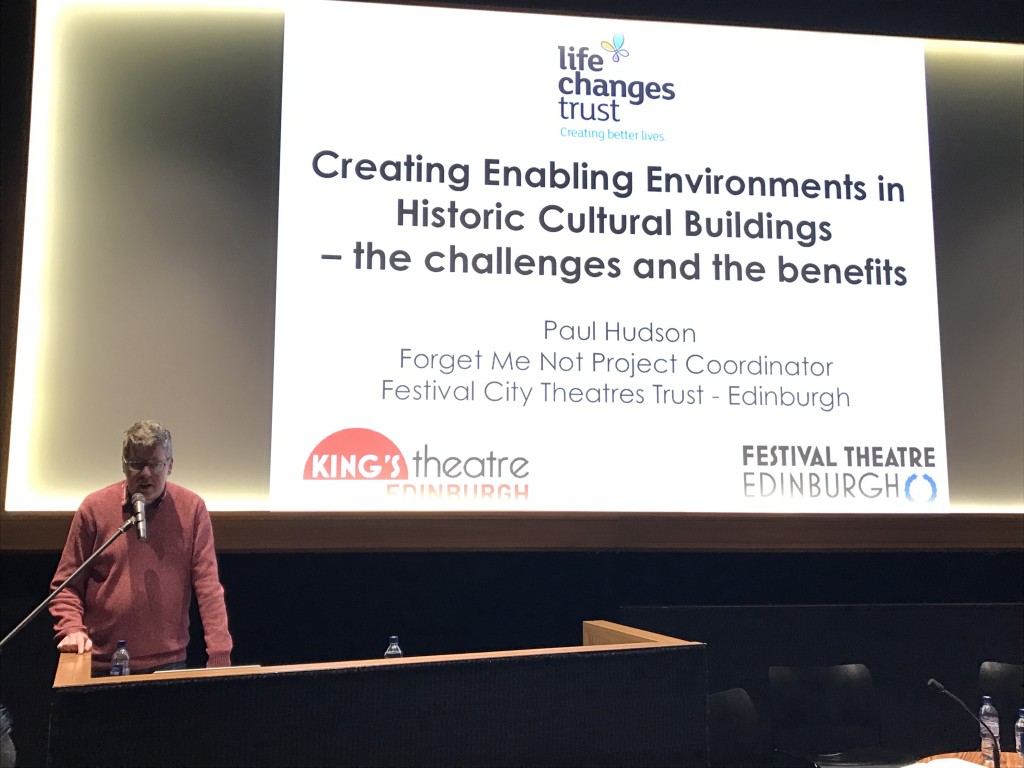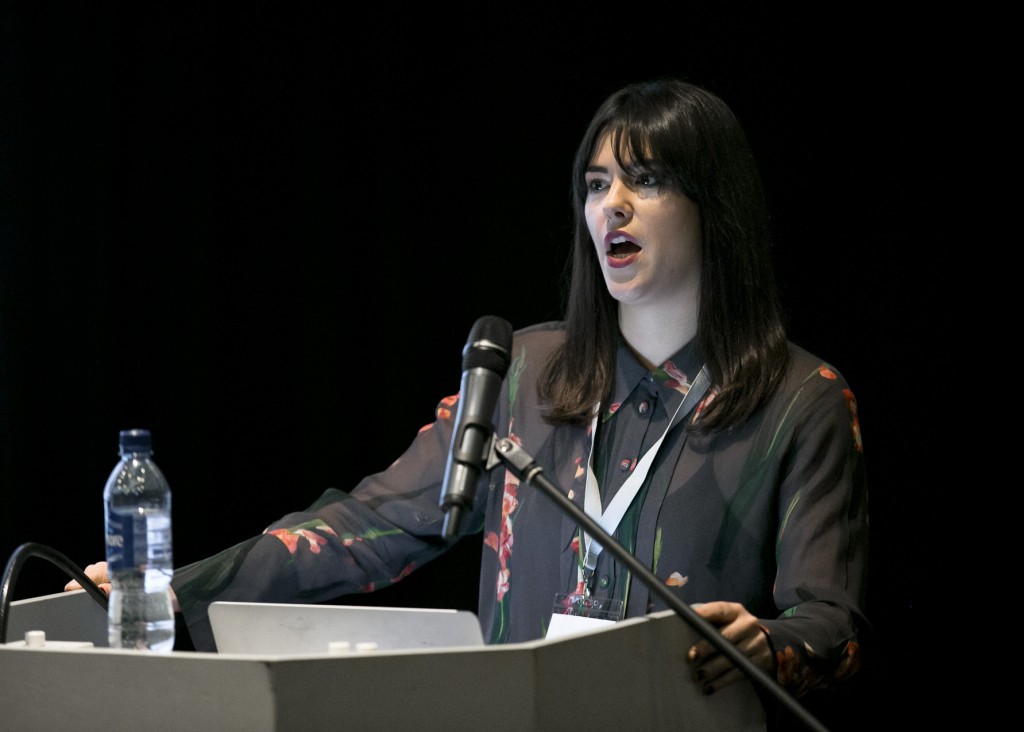Better Exhibition Through Good Design
In the exhibition business it’s all too easy not to notice the problems in your venue’s service design. You might be in the building every day but that’s precisely why what Andy Young, from Snook, working with Film Hub Central East on Cinema Know How, calls ‘pain points’ can be ignored – they’re just there, everyday. Understanding and addressing design problems means seeing what you don’t see, so consultation with communities and individuals who both do and do not visit your venue already is a good idea.
image from @bigger_pict twitter
For Paul Hudson from Kings Theatres; The Studio Theatre (2013), The King’s Theatre (1906) and The Festival Theatre (1994); the issues were many and varied as each venue’s pain points reflect the architecture, structure and design of the eras in which they were built.
So, in creating dementia friendly screenings there is a challenge in turning bricks and mortar barriers into an accessible environment. The first realisation is that what might be considered ‘romantic’ in terms of low lighting and unobtrusive signage can also be seen as obfuscating and impractical. The shade and brightness of lighting and clear, easy to see and read signage is imperative. And while funding can enable formal consultation and a greater scale of change some of these problems can be small, inexpensive alterations.
What’s most important to recognise, Hudson revealed, is that you’re never finished, it’s about, “improving, consulting, adapting, improving, consulting, adapting…” you continually need to be testing your design. But that’s the business we’re all in and that’s also called good customer service: you can improve the aesthetics of a building and your entire operation while making it dementia friendly.
Jodie Wilkinson, Head of Public Engagement at Glasgow Film Theatre, spoke next on Equality, Diversity and Inclusion at GFT:
Environments where we feel the most visible are those where we thrive.
Cinema is supposed to be all so exhibitors need to work hard to meet a diverse range of needs. GFT have worked with deaf and hard of hearing audiences to create Visible Cinema, read our case study here, with online BSL captioned promotional videos so they are reaching audiences in and outside of the physical venue. The screenings are one initiative in their aims to find out who and what the Glasgow film community is and could be. For GFT, it’s,
Never about one-off engagements but about relevance and accessibility,
Autism, dementia, deaf and hard of hearing engagement needs to be a part of the fabric of the organisation so awareness training for staff must take place alongside the audit of the physical space.
For Hudson and Wilkinson the key is finding people who can share knowledge and this is exactly what they both want to make sure they now do, because the lessons are crucial. Moderator Jon Barrenechea summed it up best:
Sometimes we think of access as serving a community with disability or a condition, but what about access for someone who has a different kind of access issue? Who else isn’t coming to the cinema and how can we open it up?
For Hudson it’s about calling it a ‘friendlier’ building, because you’ll never be completely dementia friendly – it’s a continual process. Plus, as Barrenechea pointed out, you also have to ensure that you don’t alienate people by creating special access areas that are excluded from the main spaces in your venue: don’t put a spotlight on someone’s different need, make the whole venue accessible and welcome to everyone.
The Price is Right
After lunch, the art form’s antithesis, money, came under fire. If the average ticket price in the UK for cinemas is £7.21, as Tanya Easterman from Cinema First says, and if it really is a luxury activity, then how do we bring equity to the sector and engage those with little to no disposable income, and, as the panel developed, the question was asked, do we want to?
Exhibitors and distributors are in the business of making money but they’re also responsible for social and cultural engagement and the education and development of audiences through publicly funded and supported programmes. Looking “under the bonnet” of four pricing projects, this session gave rise to a fascinating debate about what we do and why we do it in this crazy old industry.
We’ve all heard of Meercat Movies (thanks I’m sure to their multi-million pound advertising campaigns featuring the likes of Arnold Schwarzenegger and Nicole Kidman), but did we also know that it’s pulling in huge audiences and that Compare the Market is selling a lot of insurance off of the back of it? Because it is and they are.
So what happens when you don’t have the big bag of money behind your initiative? Well, as Kristy Tough, Marketing Manager at Centre for the Moving Image (Filmhouse, Belmont Filmhouse, EIFF) outlined, it’s tough. The biggest challenge for CMI is that even with a promotion that’s working – that is to say that it has a slightly higher than 2.5% return, bringing in a little over 10K and helps to widen the range and depth of engagement of audiences with films perceived to be more challenging or less accessible – it is a lot of work for a team with limited resources. Is it worth running an offer than is complicated and confusing, that requires extensive work to explain from both marketing and front of house?
Then there’s the BFI supported, Dogwoof distributed route of creating a risk-free promotion for exhibitors that aims to get films to ignored audiences. As Oli Harbottle from Dogwoof explained, holding a ‘Pay What You Can’ screening still brings in box office returns, perhaps surprisingly high at a national average of £4.16 and, while that might in fact indicate that people of means are still turning up (many cinemas will already be attracting their loyal and middle to upper class audiences) the point of the project was to make films accessible for those who wouldn’t ordinarily be able to afford the luxury that cinema offers. Dogwoof, having already worked on Loach’s Spirit of ’45, already had access to a fitting direct marketing database with contacts at trade unions and other grassroots groups. This project was spearheaded by Ken Loach and one has to wonder whether it would have been possible without such a cinematic heavy-weight at the helm.
Finally, the BFI spoke up about their Under 25 scheme, launched last year in November. They offer discounted film tickets to 16-25 year-olds, for any film at any time, 45 minutes before the film starts. While this “protects” their box office (meaning they are only really discounting empty seats) it also helps build their marketing database – you have to sign up to the scheme with your email address to get the discount. Starting out with an impressive 350 tickets sold in one month the scheme is now averaging 300 a week. They haven’t finished crunching the data just yet but anticipate the results at 80-90% new attendees. They do not, however, currently have a provision for wheel chair users, Aspergers or anxiety sufferers or others who may have difficulty turning up 45 minutes before the film in London without the certainty of seeing the film.
When asked about a national standard for young people’s schemes – many cinemas are doing it but all slightly differently – issues of price fixing came up, and so, the best possible method for engaging young people who may not be attending our venues is yet to be determined. No data or findings about whether or not the price reduction attracts younger people from lower socio-economic backgrounds was discussed so while the price may be right, we can’t yet say that equity, inclusivity and accessibility is.
Written by Tara Judah for The Bigger Picture. Keep up with everything from This Way Up on Twitter with @thiswayupcon@bigger_pict #ThisWayUp16 #biggerpicture
Photographs courtesy of Eoin Carey.







